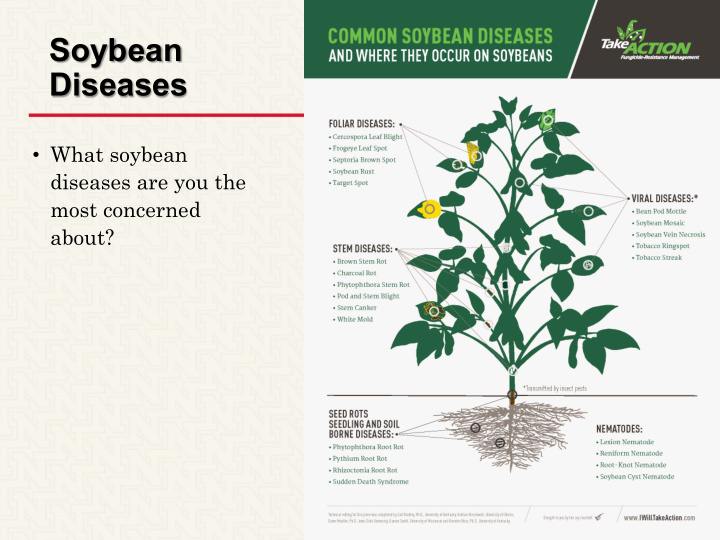



Soybean Diseases • What soybean diseases are you the most concerned about?
Frogeye Leaf Spot Management in a New Decade Nebraska Extension: Nathan Mueller, Megan Taylor, Tamra Jackson- Ziems, and Loren Giesler
Goals for Us Increase my knowledge of frogeye leaf spot Pathogen, disease cycle, and disease triangle Identification Fungicide resistance Increase my knowledge of best management practices Variety selection, crop rotation/residue, fungicide selection and resistance management Resources to utilize Developing your 2020 farm plan
Pathogen and Disease Cycle • Caused by the fungal pathogen Cercospora sojina • Disease survives in residue and in infected seed • Wind and rain spread inoculum (fungal spores) to soybean plants where infection occur • Disease cycle repeats, and spores spread to new leaves, plants, and fields • Infection at any stage, but usually after flowering, upper canopy on new leaves • Stems and pods can be infected later in the season Source: Soybean Disease Management CPN-1017 Frogeye Leaf Spot
Pathogen and Disease Cycle Environmental Conditions (70-80-85 ° F & Susceptible 90% relative humidity, frequent rainfall Variety events, 48 to 72 hours of leaf wetness) Yield Environmental loss of Conditions 0-35% Moderately Pathogen: Resistant ( Cercospora sojina ) Yield loss of Variety 0-5% High Risk: Pathogen Continuous ( Cercospora sojina ) soybean plus no-till
Frogeye Leaf Spot Identification
Frogeye Leaf Spot Identification 1. Infection at any stage, but usually after flowering, upper canopy on new leaves 2. First appears on upper leaf surfaces as small, dark, water-soaked spots 3. Small dark spots enlarge to 1/4 inch, centers change from gray to brown to light tan and surrounded by a narrow reddish purple margin 4. Lesions may coalesce, irregular areas 5. Stems and pods can be infected later in the season
Progression of Frogeye Leaf Spot
Frogeye Look-alikes Phyllosticta Target Spot Alternaria Bottom Line: Lab testing is key to proper identification
Fungicide Resistance – Weed Guide page 255 frogeye leaf spot
U.S. Counties and Year QoI (Group 11 or Strobilurin) Fungicide Resistance confirmed in Cercospora sojina causing Frogeye Leaf Spot WATCH OUT! Late 2018 Resistance may SDSU conf. 4 already be counties in SD here! #IRPests Widespread Occurrence of Quinone Outside Inhibitor Fungicide- Resistant Isolates of Cercospora sojina, Causal Agent of Frogeye Leaf Spot of Soybean, in the United States. G. Zhang, et al. 2018. Plant Health Progress 19:295-302. https://doi.org/10.1094/PHP-04-18-0016-RS
Frogeye Leaf Spot Management • Soybean varieties vary in their susceptibility and resistant varieties are available. Check with your seed company rep • Crop rotation and residue management • Scout for disease, especially following warm, moist conditions at or after flowering • Fungicides can increase yields if applied at growth stage R3- R5. Products containing a QoI (strobilurin) fungicide usually provide better control of this disease. • Resistance to QoI fungicides becoming more common and close to Nebraska • Consider a product with 2 or more modes of action • ***NOTE – If you see reduced effects of fungicides – please contact us or collect/send samples for advanced testing
2019 - QoI Fungicide Resistance Confirmed in Cercospora sojina causing Frogeye Leaf Spot in 10 Nebraska Counties #IRPests FUNGICIDE RESISTANCE IS HERE! Resistance confirmed in 111 out of 113 C. sojina isolates Neves, D., Jackson-Ziems, T., and Bradley, C. 2019. (98%)
Frogeye Leaf Spot Management – what to do when you have QoI fungicide resistance • Never use fungicides with active ingredients from single mode of action • Combine management strategies for most effective management • Frogeye resistant soybean varieties • Longer crop rotations • Use of foliar fungicides with active ingredients from 2-3 modes of action (3+7+11)
Fungicide Efficacy for Management of Frogeye Leaf Spot From the Disease Management Section of the 2020 Guide for Weed, Disease, and Insect Management and the North Central Regional Committee on Soybean Diseases NCERA-137 Rating P Rating P VG P F P P NL G-VG G-VG F-G G-VG F F VG
Fungicide Efficacy for Management of Frogeye Leaf Spot From the Disease Management Section of the 2020 Guide for Weed, Disease, and Insect Management and the North Central Regional Committee on Soybean Diseases NCERA-137 Rating Rating P-F G-VG VG G-VG VG F G F-G G-VG G-VG
Resources to Utilize 1. Soybean Disease Management Publication CPN-1017 2. UNL Weed Guide – Turn to page 272-273 3. Seed Company/Crop Adviser/Extension Educator 4. Websites 1. cropwatch.unl.edu 2. iwilltakeaction.com (examples) 3. cropprotectionnetwork.org
United Soybean Board (Checkoff) iwilltakeaction.com
Developing a 2020 Farm Plan • Know who or where to get more information (use resources mentioned… print, bookmark, etc.) • Get frogeye leaf spot resistance ratings for varieties • Work with seed dealers • Rank susceptibility of the varieties you are considering or already ordered • Rank fields for frogeye leaf spot risk (crop rotation, past pressure, past fungicide efficacy) • Scout for disease, especially following warm, moist conditions at or after flowering • Use of foliar fungicides with active ingredients from 2-3 modes of action if spraying is warranted • Use Guide For Weed, Disease, and Insect Management in Nebraska Fungicide Efficacy Table to help – page 272-273
Recommend
More recommend